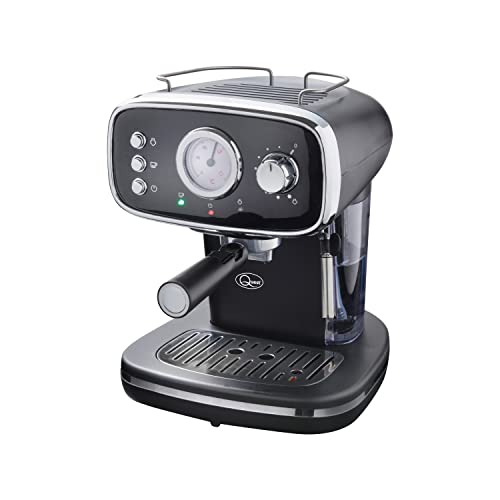How Does Machine Espresso Work?
The machine espresso makes use of precision pressure, and a filter technology that is awe-inspiring to make the coffee you enjoy. What exactly does it work?
To make espresso, hot water is forced under high pressure through finely ground coffee. The process is similar to that of making drip coffee. However, it is the pressure that makes the main difference.
The Head of the Group
As the name suggests the group head is the place you insert your portafilter when brewing espresso. It is responsible for dispersing the water into the portafilter and controlling the pressure that results from the extraction. There are several different types of group head, each with their distinct advantages and disadvantages. Some focus on temperature stability, some on pre-infusion capabilities, and still others are designed to control the lever. Some have a combination, like the E61. This is a preferred choice for baristas as it provides a variety of benefits in a single package.
As you can see from the above photo the group head is fitted with a variety of notches. You place your portafilter into these notches and twist the head to secure it. There is also a gasket made from rubber that resides inside the notches, which helps create a seal when you insert your portafilter into the machine. The notches on the head allow for a precise position of the portafilter which is vital for an even extraction.
Apart from allowing you easily insert your portafilter, the group head is responsible for maintaining a consistent temperature. This is accomplished by cycling hot water around the portafilter, and through the brew-basket, ensuring that the temperature is at the right level for extraction. This is important because even a few degrees can mean the difference between good and excellent espresso.

The Pump
Contrary to manual piston machines that use a lever to pressurize water, the rotary espresso machines use motorized pumps that provide the nine atmospheric bars of pressure required for espresso extraction. The pressure is created by removing tap water from a reservoir and pumping it through a heat exchanger prior to being pushed through the ground coffee inside the group head.
Pumps are typically cheaper and last longer than piston-driven machines. However, both types of machines can deteriorate because of excessive use and insufficient cleaning. They also create mechanical complexity and can lead to costly prices for even the most basic models.
Some espresso machines use steam pressure instead of a pump in order to brew espresso. This can result in over-extraction because the boiler that makes steam also warms the water to boil. The machines must also continually rebuild their pressure between cups. This requires energy and time.
Many espresso machines make use of either a vibration or rotary pump. A vibration model utilizes a rotating disk to generate pressure, while a rotary model pushes hot water through the ground at a high speed. Both machines can produce excellent espresso, however rotary machines are more quiet, durable and less likely to break down.
The Boiler
The boiler is the component that heats the water to the ideal temperature to extract. The steam that is produced reaches the portafilter that contains the ground espresso coffee, and gets funnelled down into the cup. The steam generates enough pressure to push the grounds of the coffee through. This produces a layer of crema on top. This is a sign of a great espresso.
There are three distinct types of espresso machines, each with distinct pumps and the temperature of the brew. There are various ways in which the brew can be controlled as well as the size of the cup that the machine can produce.
The first espresso machines were steam-type. The first espresso machines were steam-type machines. This led to the coffee tasting bitter and burnt. The modern espresso machine was developed by the Milanese producers Luigi Bezzerra & Desiderio Pavoni.
The most common espresso maker is a semi-automatic machine with an electric pump. When people think of espresso machines, they think of these machines. With a semi-automatic machine you must grind the beans and then tamp them by hand, but the pump is able to regulate the flow of water and pressure. This is a great compromise between the human touch and the mechanized accuracy.
The Filter
Espresso machines usually use filters that separate the grounds of coffee from hot water. The filter is also a crucial element of the temperature control system, as it prevents the machine from overheating.
It also improves flavor, since a filter can allow for a longer bloom phase. This allows the beans to release their flavors and provides an opportunity to improve extraction.
It is important to remember that even the best filter can result in a bad cup of coffee. The quality of the beans and the extraction, are still very important.
This is where the magic happens. It's what makes an espresso really taste great. visit web site (also known as the brewhead) is where you place the portafilter, which is the thingy that you use to put the grounds of coffee into while making espresso.
Steam-driven espresso machines use hot water that is heated in an airtight vessel to create steam. The steam then pushes hot water through grounds of the coffee under pressure. These machines are less expensive and easier to maintain than pumps-driven models. They are however limited in their ability to create the ideal conditions for brewing as they only operate with 1-1.5 bar of pressure. The perfect shot requires 9-10 bars.
In recent years, espresso machines driven by compressed air-pump are becoming increasingly popular. They use an air compressor to push the hot water through the grounds and are significantly more portable than steam-driven electric machines.
